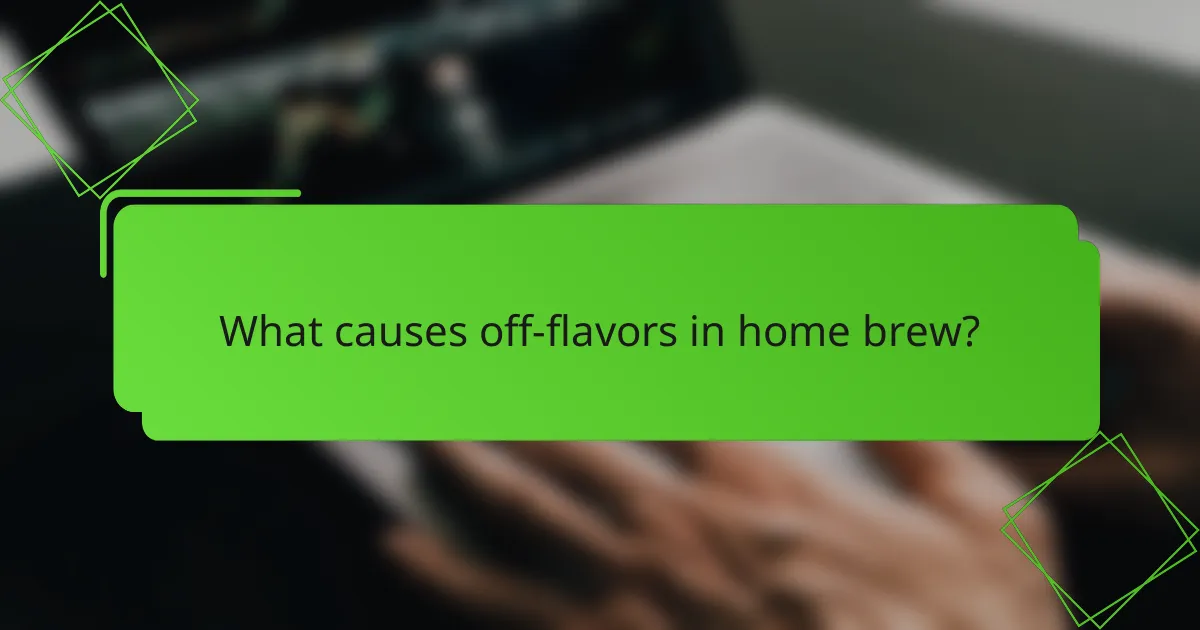Off-flavors in home brewing can significantly impact the quality and enjoyment of your beer. Common issues such as diacetyl, acetaldehyde, and oxidation often stem from fermentation problems, ingredient quality, or temperature fluctuations. By learning to identify these flavors through careful observation and testing, brewers can take corrective actions to enhance their brewing process and achieve a more desirable final product.

What are the common off-flavors in home brew?
Common off-flavors in home brewing include diacetyl, acetaldehyde, phenolic flavors, oxidation, and esters. Identifying these flavors is crucial for improving the quality of your beer and ensuring a pleasant drinking experience.
Diacetyl
Diacetyl is a buttery flavor often described as reminiscent of popcorn or butterscotch. It typically arises from yeast metabolism during fermentation, particularly when yeast is stressed or under-pitched.
To minimize diacetyl, ensure proper fermentation temperatures and provide adequate yeast health. A common practice is to allow a diacetyl rest, where the temperature is raised slightly towards the end of fermentation to encourage yeast to reabsorb diacetyl.
Acetaldehyde
Acetaldehyde has a green apple or raw pumpkin flavor and is a byproduct of yeast metabolism. It can occur when fermentation is incomplete or if the beer is exposed to oxygen.
To avoid acetaldehyde, maintain consistent fermentation temperatures and ensure that fermentation is complete before bottling. A good rule of thumb is to wait until fermentation activity has ceased and specific gravity readings are stable over a few days.
Phenolic flavors
Phenolic flavors can present as medicinal, spicy, or smoky notes, often attributed to certain yeast strains or contamination from bacteria. These flavors are more common in Belgian-style ales or when using specific grains.
To control phenolic flavors, select yeast strains carefully and maintain cleanliness during brewing. Avoid using high-temperature water for mashing, as this can extract undesirable phenolic compounds from grains.
Oxidation
Oxidation can lead to stale or cardboard-like flavors in beer, often resulting from exposure to oxygen during brewing or packaging. This off-flavor can develop over time, particularly in poorly sealed bottles or kegs.
To prevent oxidation, minimize oxygen exposure throughout the brewing process. Use proper bottling techniques, such as purging bottles with CO2 before filling, and store beer in a cool, dark place to prolong freshness.
Esters
Esters are fruity flavors that can enhance the aroma and taste of beer, but excessive levels can be considered an off-flavor. They are produced by yeast during fermentation, especially at higher temperatures.
To manage ester production, control fermentation temperatures and choose yeast strains that produce desirable levels of esters for your beer style. For example, lager yeasts typically produce fewer esters compared to ale yeasts, making them a better choice for clean, crisp beers.

How can I identify off-flavors in my home brew?
Identifying off-flavors in home brew involves careful observation of taste and aroma. By conducting taste tests, smell assessments, and consulting flavor wheels, brewers can pinpoint undesirable flavors and take corrective action.
Taste tests
Taste tests are essential for recognizing off-flavors in your home brew. Take small sips and pay attention to any unusual tastes that stand out, such as bitterness, sourness, or metallic notes. It’s helpful to compare your brew with a known good example to better identify discrepancies.
When conducting taste tests, consider using a clean glass for each sample to avoid cross-contamination. Take notes on your observations, focusing on specific flavors and their intensity, which can guide your troubleshooting efforts.
Smell assessments
Smell assessments play a critical role in identifying off-flavors, as aroma significantly influences taste. Swirl the glass gently and take a deep sniff, looking for any unpleasant or unexpected scents, such as diacetyl (buttery) or phenolic (medicinal) aromas.
To enhance your smell assessment, try to eliminate distractions and use a consistent environment. If possible, have a friend smell the brew as well, as a second opinion can help confirm your findings and provide additional insights.
Consulting flavor wheels
Consulting flavor wheels can be a valuable tool for identifying off-flavors in your home brew. These visual aids categorize various flavors and aromas, helping you pinpoint specific issues based on your observations. Common flavor wheels include those from the Beer Flavor Wheel or the Cicerone Certification Program.
When using a flavor wheel, start by matching the flavors you detect in your brew to those on the wheel. This process can help you narrow down potential causes and guide your research on how to correct the off-flavors in future batches.

What causes off-flavors in home brew?
Off-flavors in home brew can arise from various factors, including fermentation issues, contamination, ingredient quality, and temperature fluctuations. Understanding these causes helps brewers identify and mitigate undesirable tastes in their final product.
Improper fermentation
Improper fermentation is a primary source of off-flavors. This can occur due to inadequate yeast health, insufficient fermentation time, or incorrect fermentation conditions. For instance, if fermentation is too rapid, it may produce unwanted esters and phenols, leading to fruity or spicy flavors that are not intended.
To avoid these issues, ensure that yeast is properly pitched at the right temperature and allowed to ferment for the appropriate duration. Monitoring fermentation activity can help identify problems early on.
Contamination
Contamination from wild yeast or bacteria can introduce off-flavors such as sourness or vinegar-like tastes. This often happens when equipment is not properly sanitized or when ingredients are contaminated. Even small amounts of bacteria can significantly impact flavor.
To prevent contamination, always sanitize all brewing equipment thoroughly and use fresh, high-quality ingredients. Regularly check for signs of spoilage in ingredients and maintain a clean brewing environment.
Ingredient quality
The quality of ingredients used in brewing directly affects the final flavor. Old or stale hops, low-quality malt, or improperly stored yeast can lead to off-flavors. For example, oxidized malt can impart cardboard-like flavors, while stale hops may contribute undesirable bitterness.
To ensure ingredient quality, purchase from reputable suppliers and check expiration dates. Store ingredients in cool, dark places to maintain freshness and flavor integrity.
Temperature fluctuations
Temperature fluctuations during brewing and fermentation can lead to off-flavors. Yeast activity is highly sensitive to temperature changes, which can result in the production of unwanted compounds. For example, high fermentation temperatures may produce fusel alcohols, leading to harsh or solvent-like flavors.
Maintain a consistent fermentation temperature within the yeast’s optimal range, typically between 18°C and 22°C (65°F to 72°F) for ales. Use temperature control methods, such as fermentation chambers or temperature wraps, to minimize fluctuations.

What are the solutions for off-flavors in home brew?
To address off-flavors in home brew, it is essential to adjust fermentation conditions, use high-quality ingredients, maintain strict sanitation, and control oxygen exposure. Implementing these solutions can significantly improve the taste and quality of your beer.
Adjust fermentation temperature
Fermentation temperature plays a crucial role in the flavor profile of home brew. Each yeast strain has an optimal temperature range, typically between 18°C to 24°C (65°F to 75°F), where it performs best. Deviating from this range can lead to undesirable flavors, such as esters or fusel alcohols.
To manage fermentation temperature, consider using temperature control methods like a fermentation chamber or a water bath. Monitoring the temperature regularly can help prevent fluctuations that might negatively impact the beer’s flavor.
Use fresh ingredients
Using fresh ingredients is vital for producing high-quality home brew. Old or stale malt, hops, and yeast can introduce off-flavors and diminish the overall quality of your beer. Always check the packaging dates and opt for ingredients from reputable suppliers.
When possible, purchase hops in small quantities to ensure freshness, and store them in a cool, dark place. Similarly, use malt and yeast within their recommended shelf life to avoid any negative impact on flavor.
Improve sanitation practices
Sanitation is critical in home brewing to prevent contamination that can lead to off-flavors. Ensure that all equipment, including fermenters, bottles, and utensils, are thoroughly cleaned and sanitized before use. Common sanitizers include Star San and iodine-based solutions.
Develop a routine for cleaning and sanitizing after each brew session. This practice not only helps maintain flavor integrity but also reduces the risk of spoilage and infection.
Control oxygen exposure
Oxygen exposure can lead to oxidation, resulting in stale or cardboard-like flavors in your home brew. To minimize oxygen contact, use techniques such as purging kegs with CO2 before filling and avoiding splashing during transfers.
Additionally, consider using closed transfer systems and ensuring that all containers are sealed properly. Being mindful of oxygen exposure throughout the brewing process can significantly enhance the final product’s taste.

How can I prevent off-flavors in future batches?
To prevent off-flavors in future homebrew batches, focus on maintaining cleanliness and monitoring fermentation conditions. These two factors are crucial in ensuring that your beer develops the desired flavors without unwanted contaminants.
Regular equipment cleaning
Consistent cleaning of brewing equipment is essential for preventing off-flavors. Residues from previous batches can harbor bacteria and wild yeast, leading to undesirable tastes. Use a non-abrasive cleaner specifically designed for brewing equipment, and ensure that all items, including fermenters, bottles, and utensils, are thoroughly sanitized before use.
Establish a routine cleaning schedule after each brewing session. This may include soaking equipment in a cleaning solution for a specified time, followed by a thorough rinse. Regularly inspect your equipment for any signs of wear or damage that could harbor contaminants.
Monitoring fermentation conditions
Proper fermentation conditions significantly influence the flavor profile of your beer. Maintain a stable temperature within the recommended range for the yeast strain you are using, as fluctuations can lead to the production of off-flavors. Most ale yeasts thrive between 18°C and 22°C, while lager yeasts prefer cooler temperatures around 8°C to 12°C.
Additionally, ensure that fermentation vessels are sealed properly to prevent exposure to oxygen, which can lead to oxidation and off-flavors. Consider using a temperature control system or fermentation chamber to maintain ideal conditions, especially during warmer months.

What tools can help identify off-flavors?
Identifying off-flavors in homebrew requires specific tools that can enhance sensory evaluation. Common tools include flavor kits, tasting glasses, and even software for tracking brewing processes.
Flavor Kits
Flavor kits are essential for homebrewers aiming to recognize off-flavors. These kits typically contain small samples of various flavor compounds, allowing brewers to taste and compare them against their own brews. By familiarizing yourself with these flavors, you can better identify unwanted tastes in your beer.
When using a flavor kit, take notes on each sample and how they compare to your brew. This practice helps in pinpointing specific off-flavors and understanding their origins.
Tasting Glasses
Using proper tasting glasses can significantly impact the identification of off-flavors. Glasses designed for tasting, such as tulip or snifter shapes, concentrate aromas and enhance the overall sensory experience. This allows for a more accurate assessment of the beer’s flavor profile.
Ensure your glasses are clean and free from residues that could mask off-flavors. A simple rinse with hot water before use can help maintain clarity in tasting.
Brewing Software
Brewing software can assist in tracking variables that may lead to off-flavors. Programs often include features for logging ingredients, fermentation temperatures, and other critical parameters. By analyzing this data, you can identify patterns that correlate with undesirable flavors.
Consider using software that allows for recipe adjustments and provides feedback on potential flavor outcomes. This proactive approach can help prevent off-flavors before they occur in future batches.



